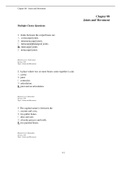Summary
Summary vxcvxv
- Course
- 103
- Institution
- Simon Fraser University (SFU )
1. Introduction to Archaeology Definition and Scope: Archaeology is the scientific study of human history through the excavation and analysis of material remains. It involves recovering artifacts, structures, and other physical evidence to understand past human behavior and cultural practices. M...
[Show more]






